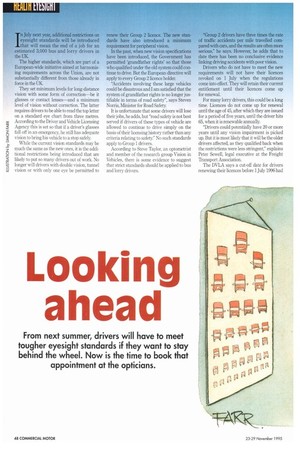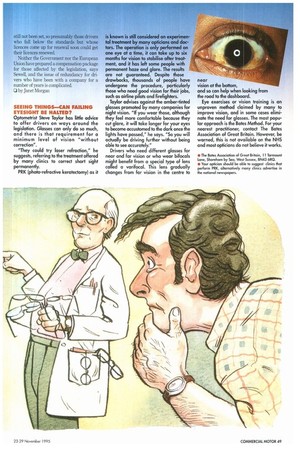Looking ahead
Page 50

Page 51

If you've noticed an error in this article please click here to report it so we can fix it.
From next summer, drivers will have to meet tougher eyesight standards if they want to stay behind the wheel. Now is the time to book that appointment at the opticians. n July next year, additional restrictions on eyesight standards will be introduced that will mean the end of a job for an estimated 3,000 bus and lorry drivers in the UK.
The higher standards, which are part of a European-wide initiative aimed at harmonising requirements across the Union, are not substantially different from those already in force in the UK.
They set minimum levels for long-distance vision with some form of correction—be it glasses or contact len,.,es and a minimum level of vision without correction. The latter requires drivers to be able to read the top letter on a standard eye chart from three metres. According to the Driver and Vehicle Licensing Agency this is set so that if a driver's glasses fall off in an emergency, he still has adequate vision to bring his vehicle to a stop safely.
While the current vision standards may be much the same as the new ones, it is the additional restrictions being introduced that are likely to put so many drivers out of work. No longer will drivers with double vision, tunnel vision or with only one eye be permitted to renew their Group 2 licence. The new standards have also introduced a minimum requirement for peripheral vision.
In the past, when new vision specifications have been introduced, the Government has permitted 'grandfather rights' so that those who qualified under the old system could continue to drive. But the European directive will apply to every Group 2 licence holder.
"Accidents involving these large vehicles could be disastrous and Tam satisfied that the system of grandfather rights is no longer justifiable in terms of road safety", says Steven Norris, Minister for Road Safety.
It is unfortunate that some drivers will lose their jobs, he adds, but "road safety is not best served if drivers of these types of vehicle are allowed to continue to drive simply on the basis of their licensing history rather than any criteria relating to safety:" No such standards apply to Group 1 drivers.
According to Steve Taylor, an optometrist and member of the research group Vision in Vehicles, there is some evidence to suggest that strict standards should be applied to bus and lorry drivers. "Group 2 drivers have three times the rate of traffic accidents per mile travelled compared with cars, and the results are often more serious," he says. However, he adds that to date there has been no conclusive evidence linking driving accidents with poor vision.
Drivers who do not have to meet the new requirements will not have their licences revoked on 1 July when the regulations come into effect. They will retain their current entitlement until their licences come up for renewal.
For many lorry drivers, this could be a long time. Licences do not come up for renewal until the age of 45, after which they are issued for a period of five years, until the driver hits 65, when it is renewable annually.
"Drivers could potentially have 20 or more years until any vision impairment is picked up. But it is most likely that it will be the older drivers affected, as they qualified back when the restrictions were less stringent," explains Peter Sewell, legal executive at the Freight Transport Association.
The DVLA says a cut-off date for drivers renewing their licences before 1 July 1996 had still not been set, so presumably those drivers who fall below the standards but whose licences come up for renewal soon could get their licences renewed.
Neither the Government nor the European Union have prepared a compensation package for those affected by the legislation, says Sewell, and the issue of redundancy for drivers who have been with a company for a number of years is complicated.
by Janet Morgan SEEING THINGS—CAN FAILING EYESIGHT BE HALTED?
Optometrist Steve Taylor has little advice to offer drivers on ways around the legislation. Glasses can only do so much, and there is that requirement for a minimum level of vision "without correction".
"They could try laser refraction," he suggests, referring to the treatment offered by many clinics to correct short sight permanently.
PRK (photo-refractive keratectomy) as it
is known is still considered an experimental treatment by many opticians and doctors. The operation is only performed on one eye at a time, it can take up to six months for vision to stabilise after treatment, and it has left some people with permanent haze and glare. The results are not guaranteed. Despite those drawbacks, thousands of people have undergone the procedure, particularly those who need good vision for their jobs, such as airline paws and firefighters.
Taylor advises against the amber-tinted glasses promoted by many companies for night vision. "If you wear those, although they feel more comfortable because they cut glare, it will take longer for your eyes to become accustomed to the dark once the lights have passed," he says. "So you will actually be driving further without being able to see accurately." Drivers who need different glosses for near and far vision or who wear bifocals might benefit from a special type of lens called a varifocol. This lens gradually changes from for vision in the centre to near vision at the bottom, and so can help when looking from the road to the dashboard.
Eye exercises or vision training unproven method claimed by many to improve vision, and in some cases eliminate the need for glasses. The most popular approach is the Bates Method. For your nearest practitioner, contact The Bates Association of Great Britain. However, be warned, this is not available on the NHS and most opticians do riot believe it works. is an












































































































